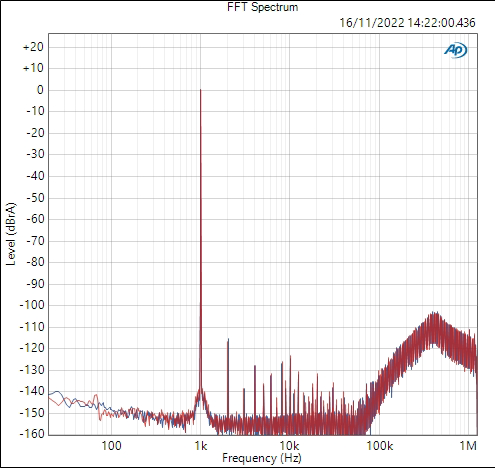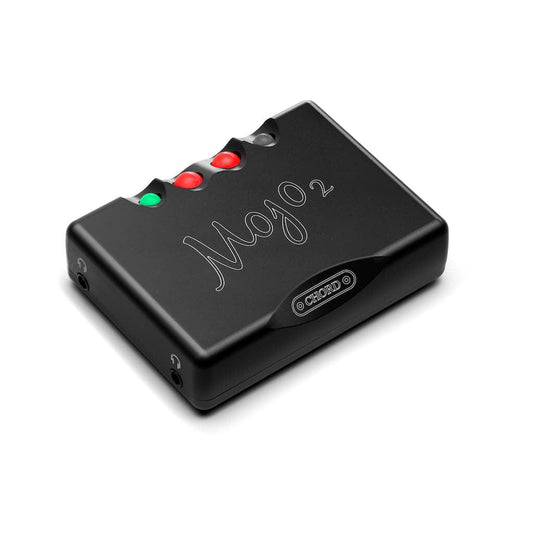Chord Mojo 2 Review & Measurements

Chord Electronics Mojo 2 Portable DAC and Headphone Amplifier
Introduction
The Chord Mojo 2 is a very interesting device, offering Chord’s pulse array DAC design, some handy features such as configurable EQ and Crossfeed, and some of the highest performance oversampling found in any DAC on the market, all in a very compact package.
Subjectively, I wasn’t much of a fan of the original Mojo, but after trying the Mojo 2 at a meet I was very impressed, and later purchased one to use as my personal on-the-go source. This unit was purchased with my own funds at full retail price, all thoughts and opinions are my own.
The Mojo 2 sits in a bit of a unique form factor. You can’t really call it a ‘dongle’, but it isn’t a standalone DAP and does require a phone or other source device.
It also has some upgrades for use at the desk compared to the original Mojo, such as an ‘Intelligent desktop mode’ that allows you to keep it plugged in 24/7 without degrading the battery capacity.
Design
The inside of the Mojo 2 shows an impressive amount of compute power for such a small device, with an ATSAM3U1C microcontroller and an ARTIX-7 FPGA.

The microcontroller is likely acting as the USB receiver, with the ARTIX-7 FPGA handling the oversampling and DSP functionality, as well as controlling the pulse array converter itself, which can be seen just to the right of the FPGA. This is what is outputting the analog signal, it does not come directly from the FPGA.
This pulse array then feeds the output stage nested between the two 3.5mm jacks. It’s a common misconception that Chord DACs don’t have an output stage, this is not the case.
The engineer behind Chord’s DAC designs, Rob Watts, tried to keep as few components in the signal path as possible, but they do indeed have an output stage.
The Mojo 2 is controlled using the four RGB illuminated buttons on the front. The aesthetic of this is going to be polarizing, but it fits with the rest of Chord’s line-up.

I personally found it quite tricky to remember how to configure things for the first couple days, and had to have the manual constantly to hand, but after a while you do get used to it. It would have been nice to have a slightly more intuitive control scheme especially given the multitude of options to configure on the Mojo 2.
There are four configurable EQ options which are adjustable upto +/- 9dB in 1dB increments.


Additionally there is a crossfeed feature which many will no doubt appreciate. This feeds some of the signal from the right channel into the left and vice versa, but attenuated and with a miniscule delay. This aims to emulate the effect of listening to a pair of speakers, where each ear is able to hear both the left and right channels but at slightly different volumes and times. As opposed to headphones where each ear only hears one channel.
The I/O is a bit on the polarizing side too.
The Mojo 2 does thankfully include both a USB-C and Micro-USB port for data, so you should have no issue connecting this to any device with whatever cable you have to hand. However, you can only charge the Mojo 2 using the secondary micro-USB port.
There is also no charger in the box, so you need to ensure you have a micro-USB 5V charger with at least 2A capability before you will be able to charge the device.

The layout has been kept similar to the original Mojo so that the Chord Poly can be used in conjunction with it.
Review
Measurements
Measurements Include:
- THD+N (SINAD)
- THD+N vs Frequency
- THD+N vs Output Level
- Low Level Signal Output
- Nyquist Reconstruction Filter / Oversampling
- Noise when Idle
- Intermodulation Distortion (IMD)
- Linearity
- Crosstalk
- Jitter
- Multitone
- Wideband Noise & Distortion
Additional measurements and test information available in the full reports
Test Setup
- Audio Precision APx555 B-Series Analyzer
- 100kΩ Input Impedance used unless otherwise stated
- USB Source: Intel PC via intona 7055-C isolator
- Coax SPDIF source: Audio Precision APx555 B-Series
- Measurement setup and device under test are running on regulated 230V power from a Furman SPR-16-Ei
- Mojo 2 was warmed up for 3 hours prior to testing
- Mojo 2 was fully charged, and then ran on battery during testing
- Exact analyzer/filter configurations for each measurement are detailed in the full reports
- CH1 (Blue) = Left, CH2 (Red) = Right
A few important points to note before moving onto the measurements themselves:
1) In most tests the Mojo 2 performed near identically when running on battery vs in ‘intelligent desktop mode’ fed by an iFi iPower 5V power supply. Tests shown are using battery as this is likely representative of how the majority of people will use the device.
2) When the Mojo 2 is connected directly to a PC via USB, it seems to show some additional noise content from about 7khz upwards. Not to any extent that is likely to be of concern, but this can be addressed with the use of a galvanic isolator such as the Intona 7055-C, or possibly a decent filter such as the iFi iPurifier 3.0. Given as the Mojo 2 is most likely to be used on the go with a phone, I think it’s most appropriate to show the performance with a low noise (and ungrounded) source anyway. So all measurements shown are with the device isolated from the PC.
3) The Mojo 2 was set to 4.3V output for these tests. This is because the Mojo 2 begins clipping above this level, so it is the maximum practical output of the device (despite the volume control allowing the user to set it higher), and also because the volume control is entirely DSP. Therefore reducing the volume to 2V RCA line level or to a headphone listening level for the tests would just be sacrificing 6dB+ of dynamic range for no benefit. Noise floor does not change when reducing volume.
If you’d like to see performance at 2V you can look at the -7dB or 2V point on the graphs.
Full Measurement Reports
Full Report (USB, Galvanically isolated)
Full Report (USB, Direct to PC)
Results
Dynamic Range (AES17): 117.7dB
SNR: 118.8dB
IMD SMPTE: -96.0dB
Noise Level RMS (20-20khz): 4.959uVrms
Noise Level RMS (20-90khz): 16.72uVrms
DC Offset: 5.7mV active, 2.8mV idle
Latency: 29.14ms
Susceptible to intersample overs: No (as long as you are more than 3dB below 4.3V, which you pretty much always will be)
THD+N / SINAD
1khz 0dBFS Sine, 4.3V output (max level without clipping):

1khz 0dBFS Sine, 2V output (RCA Line Level):

1khz 0dBFS Sine, 700mV output (Headphone Level):

1khz 0dBFS Sine, 50mV output (IEM Level):

THD+N vs Frequency

(AES 20khz filter applied on the analyzer. Provides more relevant THD+N values at lower frequencies as noise above 20khz is ignored, but causes dips in THD+N readings at higher frequencies because harmonics above 20khz are ignored. After 10khz, all harmonics are above 20khz and are therefore ignored.)

(96khz bandwidth used on the analyzer. Provides less relevant THD+N values at lower frequencies as noise above 20khz is factored in, but shows a more accurate profile of rising distortion if present, as harmonics above 20khz are still counted.)
The mojo 2 does have some small amount of rising THD into the higher frequencies. This persists regardless of level.
Whilst from an objective standpoint, lower THD is better, from a subjective standpoint, this can contribute to a subjectively ‘sweeter’ or ‘warmer’ presentation which many people like. This is much less drastic on the Mojo 2 than some other devices, and combined with the fact that the Mojo 2’s distortion profile is almost entirely 2nd order unless outputting very high levels, and therefore more easily masked by the fundamental, it’s very unlikely to be audible.
THD+N vs Output Level

Low Level Signal Output
-90.31dBFS 1khz sine played through device

96khz capture bandwidth

20khz filter applied
Reconstruction Filter
White noise at 44.1khz sampling rate played through device

10khz to 96khz shown

Zoomed to more clearly show area around the nyquist frequency
Chord’s oversampling filter is something that they do better than any other manufacturer I am aware of currently. In the case of the Mojo 2, offering a 40,960 tap/coefficient filter. Leagues ahead of the usually 128-1024 tap filters in most modern DAC chips. This means that the Mojo 2 can fully represent all content up to the Nyquist frequency of 22.05khz, whilst having next to no unwanted ultrasonic content/imaging. This means that the Mojo 2 adheres to Nyquist theorem better than most DACs, and should be able to represent the timing of transients more accurately as a result. Research into the audibility of high performance reconstruction filters is extremely limited, and therefore audibility thresholds are up for debate. But hey, it’s always nice to see something done well, even if you may feel it’s of no audible benefit.
Noise When Idle

IMD

Linearity

Crosstalk

Jitter

USB input, 44.1khz

USB input, 48khz
Jitter shown is when using USB input. Though both SPDIF inputs were equally excellent. The Mojo 2 has practically perfect jitter performance. This is another thing that Chord DACs do REALLY well and is seemingly an inherent benefit of the pulse array design.
They are not ‘immune’ to jitter, but are immensely resistant to it.
Even when putting it on optical and deliberately adding 25nS of 1khz sine jitter to simulate a truly awful source device, the Mojo 2 still had very good jitter performance.
You can be certain that regardless of the source you use, jitter performance on the Mojo 2 will be excellent.
Multitone

Wideband Noise & Distortion

Idle

Active (-3dBFS 1khz Sine Playing)


